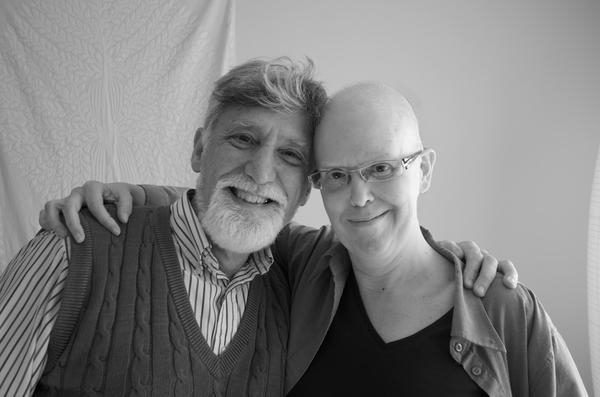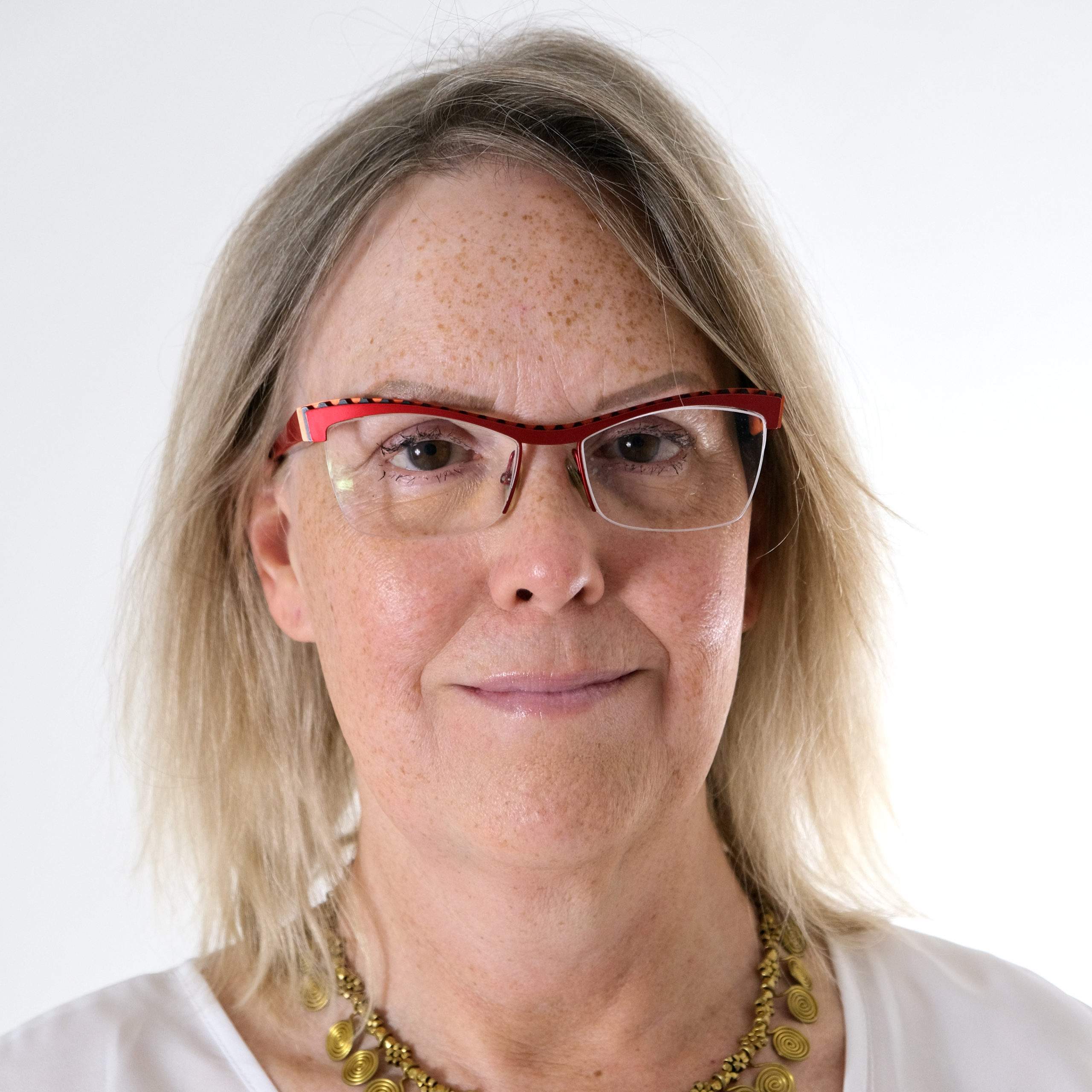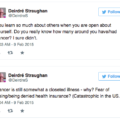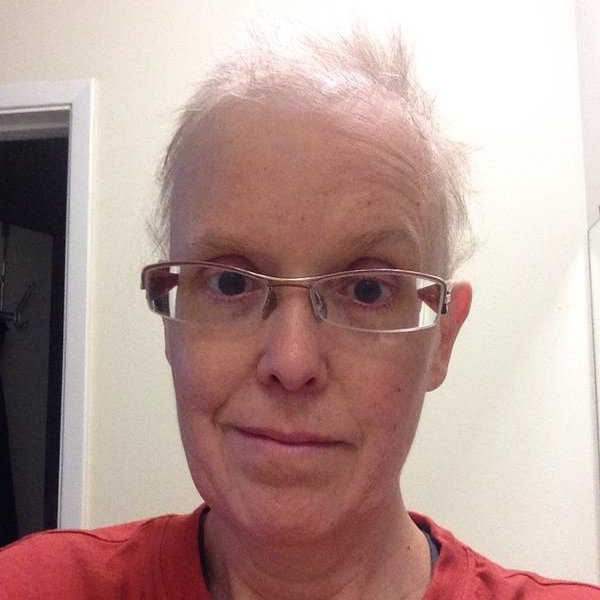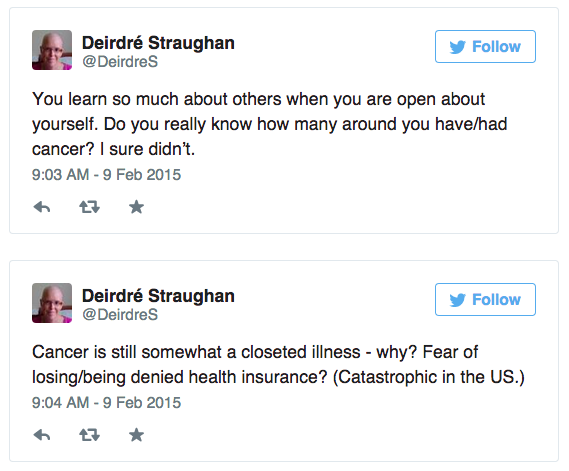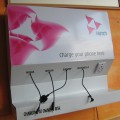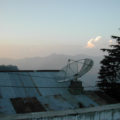After many weeks of blood tests, my usual vein is getting tired of being poked – hurts now. Yet another unexpected side effect.
— Deirdré Straughan (@DeirdreS) April 1, 2015
In weekly pre-chemo check, onco told me “Patients usually want to quit about Round 7 or 8.” I’m long past /wanting/ to quit. But… on we go.
— Deirdré Straughan (@DeirdreS) April 1, 2015
Chemo infusion unpredictable. Some of the pre-meds today made me sick, dizzy, and stoned. Now just stoned, may burst into song in the chair.
— Deirdré Straughan (@DeirdreS) April 2, 2015
Ah, taxol. Fingers are tingling. No, this is not a good thing.
— Deirdré Straughan (@DeirdreS) April 2, 2015
Day after infusion and I actually feel… almost fine. Let’s hope this trend continues.
— Deirdré Straughan (@DeirdreS) April 3, 2015
April 5 – 6.3
Felt great on Friday, worked, cleaned house, went grocery shopping, and only got a little tired in the afternoon (but did not nap). Have been eating well, lots of red meat (stew, pork carnitas, making lamb tagine today). But… had muscle spasms in my abdominal muscles again last night, and have intestinal cramps again today, and a few spasms in my left thigh. Food poisoning not likely this time. Took ibuprofen, we’ll see if that works. I’ve had very broken sleep the last few nights, waking up a lot.
Filing. It is somewhat daunting to have a large folder marked “Cancer”.
— Deirdré Straughan (@DeirdreS) April 6, 2015
April 6 – 6.4
Slept better last night. Neck and shoulder have been stiff and sore the last few days, going back to my molded memory foam pillow to see if that helps.
2 cups of tea today, not sure that’s a good idea.
Just feel kind of… burnt.
April 7 – 6.6
I keep wanting to just feel normal, have to remind myself: “It’s ok to feel bad, you’re doing @%$$ chemo!”
— Deirdré Straughan (@DeirdreS) April 7, 2015
One of the more annoying side effects is that, whenever I go outside, my eyes start streaming, to the point that my vision is blurry and my face gets irritated from tears. Very tired today, though so far I have not really succeeded in napping.
April 8 – 6.7
Devastatingly tired. Dr L said red cell counts were very low, so I have to have neupogen shots Friday, Monday and Tuesday. In the evening, felt depressed and anxious.
Chemo -> anemia -> depression and anxiety. Knowing there’s a physical cause doesn’t make the mental symptoms much easier.
— Deirdré Straughan (@DeirdreS) April 9, 2015
Also: it is harder to get warm when you don’t have much hemoglobin. Where’s a hot flash when I need one?
— Deirdré Straughan (@DeirdreS) April 9, 2015
April 9 – 7.1
In the chair again, this time taxol is going ok, though I dislike the high from the pre-meds (antinausea and benadry). Got it all done in about 3.5 hours, was quite productive this afternoon, thanks to the benadryl buzz. Towards evening, some rippling spasms in my colon. Now a bit tired.
Another day in the chair. This cocktail of pre-meds they give me results in a very unpleasant high.
— Deirdré Straughan (@DeirdreS) April 9, 2015
And I forgot to put lidocaine on the skin over the port this morning. Now we’ll find out whether this skin is as generally numb as I think.
— Deirdré Straughan (@DeirdreS) April 9, 2015
Annoying chemo side effect: “senior moments”. Meant to make couscous, cooked polenta instead. Olive oil in polenta turns out not to work.
— Deirdré Straughan (@DeirdreS) April 10, 2015
Evening: wasn’t hungry much, but ate at 10pm. Now cramps. Mild so far.
April 10 – 7.2
Poor sleep – awake from 4 to 530 I think, dead asleep (also thanks to ambien) when my alarm went off at 8. Went to dermatologist, had two moles frozen (ouch!), then got neupogen shot. Now tired, could be lack of sleep.
Turns out having moles burned off hurts a lot, though not for too long. PS: Having cancer doesn’t excuse you from other ills (I wish!).
— Deirdré Straughan (@DeirdreS) April 10, 2015
I get v tired after eating. Apparently I don’t have enough blood circulating to handle my digestive system & anything else at the same time.
— Deirdré Straughan (@DeirdreS) April 10, 2015
Apr 11 – 7.3
Took M to the park, then we parked and walked to eat an unexciting burger. Came home and have been in bed ever since. I don’t quite feel like I really slept, but time is moving faster than I would expect if I had been awake. Sometimes this is very like jet lag.
While we were out and about, I could feel a rushing sensation in my left upper chest (near the port) and upper arm, as if I could feel the blood moving through a vein there.
Managed to spend a few hours doing normal stuff today. Have been prostrate the rest of the day. Sigh. I hate not bring me.
— Deirdré Straughan (@DeirdreS) April 12, 2015
Apr 12 – 7.4
Slept somewhat better. Temp regulation at night a problem.
Apr 13 – 7.5
Had the 2nd neupogen shot (Brendan drove), this one in my left arm. But I have pain in the right arm, at the site of Friday’s injection. ??? Pretty bad day with fatigue and depression. Actually low enough to watch TV. Once in the evening, stood up and felt dizzy, could hear the blood rushing in my head.
Apr 14 – 7.6
Got a decent night’s sleep and felt a bit better this morning (neupogen increasing white cell counts, perhaps). Managed to drive myself to today’s shot and then grocery shopping. Unpacked groceries, cleaned old stuff out of the fridge, have done a bit of work but, as usual, dead tired after eating.
@fatneckbeardguy @kf @jacobian Yes, sadly – meds will screw you up, coming and going! And not always easy to know when they’re affecting you
— Deirdré Straughan (@DeirdreS) April 14, 2015
The oncology waiting room is always humbling. I’m on a tough chemo regime, but still so much better off than so many. All so brave.
— Deirdré Straughan (@DeirdreS) April 14, 2015
Another thing about chemo: was much harder for anyone who did it even a few years ago. Side effects e.g. nausea much more controllable now.
— Deirdré Straughan (@DeirdreS) April 14, 2015
I get twinges in my chest, maybe around where the end of the catheter sits in the vein.
Apr 16 – 8.1
In the chair for round 8 (out of 20) of chemo. Let the unpleasant high begin…
— Deirdré Straughan (@DeirdreS) April 16, 2015
Miscalculated earlier: this round 8 of 16 chemo infusions. So, over half way now.
— Deirdré Straughan (@DeirdreS) April 16, 2015
Feeling ok after today’s chemo. Problem is completely brain fogged from the anti-nausea, antihistamines, and steroids they also gave me.
— Deirdré Straughan (@DeirdreS) April 16, 2015
@bobthomson70 Yes, still working. For me, it’s the best therapy – keeps me engaged and feeling useful. So grateful for a supportive employer
— Deirdré Straughan (@DeirdreS) April 16, 2015
@hypervisaac Thanks. The unpredictability is maddening – I can’t plan much.
— Deirdré Straughan (@DeirdreS) April 17, 2015
I was having neuropathy – numbess, tingling, and hot/cold, especially in my feet, before the taxol started. Dr L advised Vits B6 and B12, and they seem to be working! Have had a few occasional tingles since starting taxol, but not bad at all. Infusion went smoothly, started at 1030 ended around 1. Then B drove me over to the hospital to pick up contrast drinks for Monday’s CT scan. Having that because I’m still getting abdominal pain/cramps, occasionally enough to wake me up at night. Dr L says maybe I got something at that Burmese restaurant the night before Taxol started, and because my immune system has been down, it’s lingering on. But… we scan. I felt both stoned/sleepy and wired after infusion, then slept badly – woke up a lot and had trouble sleeping again, in spite of ambien.
Apr 18 – 8.3
I kept waking up due to dry mouth or whatever. This morning I felt good, got some writing done, then Pamela visited, and Meena briefly.
Thanks to Meena and Pamela, I have a most excellent veg thali for lunch today! pic.twitter.com/9ysCk6w8ER
— Deirdré Straughan (@DeirdreS) April 18, 2015
Went out briefly, shopping, and after that I was done in.
My appetite and specific tastes keep changing. I have wasted a lot of food during these months because I’m bad at predicting what I will like and keep on liking (or even be able to stand the smell/taste/thought of). The unpredictability of everything about chemo makes it that much harder.
Feeling anxious and irritable and unwell. The Tudor court is probably a good distraction.
— Deirdré Straughan (@DeirdreS) April 20, 2015
Apr 20 – 8.5
This morning’s smoothie is barium sulfate. Yum – not!
— Deirdré Straughan (@DeirdreS) April 20, 2015
@dstengle Had to sip (ice) – somewhere towards the bottom of eat bottle, it was hard not to vomit it back.
— Deirdré Straughan (@DeirdreS) April 20, 2015
CT scan this morning to try to determine why I’m getting abdominal spasms/cramps (which were stronger last night than they had been in a while, reason unclear). This meant waking up at 4:30am to drink a contrast solution, and drinking another at 7:30 just before leaving for the hospital. Then had to also have I/V contrast into my arm. The whole thing was over quickly, Dr L should have results by the time we meet Wednesday. Turns out the contrast drink is a laxative – I have shit more today than at any time since chemo began. Which is tiring and painful, but… at least I’ll be well purged, and constipation should not be a problem for a bit. Cramps continued fairly nasty into the night. Correlated with something I ate? Broccolini twice the day before?
Apr 21 – 8.6
Felt fine this morning until coffee/smoothie. Maybe eliminate caffeine. 10am – Ate a souffle and half a pastry from Panera. Cramps. Tired. slept ~1130-1230
@doublehelix @embeedub As someone else said, my body is the battleground where doctors & the cancer fight it out.
— Deirdré Straughan (@DeirdreS) April 21, 2015
Ate an early dinner (630) and a late one (10), pork tenderloin with apples and onions, mashed potatoes salad. Cramps after, but gone by the time I went to sleep.
Today has been productive, interspersed with nap. Maybe that’s how I need to manage chemo.
— Deirdré Straughan (@DeirdreS) April 22, 2015
One of my oldest and dearest friends is coming across the country next week to visit. I couldn’t have a better gift.
— Deirdré Straughan (@DeirdreS) April 22, 2015
Week after my friend’s visit, I get my daughter! Going to be a happily busy couple of weeks.
— Deirdré Straughan (@DeirdreS) April 22, 2015
Apr 22 – 8.7
This morning had a small espresso around 645, then smoothie (fruit and yogurt) at 945. Felt fine til after smoothie, now tired, burny feeling in stomach/intestine.
Blood draw only a finger prick today. I guess that’s progress.
— Deirdré Straughan (@DeirdreS) April 22, 2015
1130 – ate toast, egg, ham.
later – CT scan result: severe constipation. Prescription: prunes.
Good news/bad news: I had to have a CT scan to tell me I need to eat prunes. (Chemo causes severe constipation.)
— Deirdré Straughan (@DeirdreS) April 22, 2015
White cells low, will be doing neupogen again next Mon-Weds. Red cells better.
From those of us who have cancer to those of you who lie about it and peddle bullshit: fuck you. http://t.co/289KlLSK4G
— Deirdré Straughan (@DeirdreS) April 23, 2015
Apr 23 – 9.1
@kebesays Yup, saw and tweeted it yesterday. I share @xeni’s rage. People so want to believe there’s an easier way. Not yet there isn’t.
— Deirdré Straughan (@DeirdreS) April 23, 2015
Time for Chemo Potion #9
— Deirdré Straughan (@DeirdreS) April 23, 2015
I’m actually feeling surprisingly good today, for the moment like my old/real self. Feeling loved & useful a huge part of this – thanks all!
— Deirdré Straughan (@DeirdreS) April 23, 2015
Current theme song (heavy cocktail of chemo pre-meds going in) http://t.co/RSzAyY3sPI
— Deirdré Straughan (@DeirdreS) April 23, 2015
Feeling surprisingly good today.
That lasted most of the day. Dinner was tricky – at first all I could think of that sounded appealing was a smoothie, but I was still hungry. Tried making open-faced goat cheese and chutney sandwiches, but the texture and flavor both turned out unappealing. Then brushed my teeth and my mouth may have bled – seem to have sores developing on the inside of both cheeks. Damn.
Feet and hands a bit burny.
Body temp all over the place, hot and cold flashes.
I think they gave me the good drugs in chemo today. Sadly now wearing off, except maybe the one that won’t let me sleep.
— Deirdré Straughan (@DeirdreS) April 24, 2015
Apr 24 – 9.2
Restless sleep, probably due to chemo pre-meds (although steroid dose was only 5mg – by my request, half the previous week’s dose). Still a bit wired but also very tired today. Bought some fiber stuff, will try taking it every day, since prunes are not enough for my constipation.
Was listening to music while in chemo yesterday. Now have “19th Nervous Breakdown” stuck in my head.
— Deirdré Straughan (@DeirdreS) April 25, 2015
Visits from two dear friends today, and assorted other adventures – all good, but… I think I’ve used up my energy for the weekend!
— Deirdré Straughan (@DeirdreS) April 26, 2015
Always great to see Tony Boccaccio http://t.co/SxZhCMsKEv – who currently has a lot more hair than I do! pic.twitter.com/EsyjL0F4VE
— Deirdré Straughan (@DeirdreS) April 26, 2015
NB: Tony, a maker of beautiful photographs, leads the wonderful Imaging in Italy course that I was on years ago http://t.co/kYrLaFdYcE
— Deirdré Straughan (@DeirdreS) April 26, 2015
Apr 28
Constipation almost solved, with fiber and prunes. Eating somewhat more, though a lot of it doesn’t taste right. Fatigue getting worse. Before, I could cook. Now I don’t have the energy. Weird chemo side effects (maybe): completely misremembering numbers, and getting songs stuck in my head even more than I used to. Also, blood pounding in my ears sometimes when I stand up.
Apr 29
Dr L says white cell counts high enough that he called off the third Neupogen shot I was to have had today, says this will probably hold me through the next cycle. I complained about problems sleeping the night of chemo, but the steroid dose is already as low as it can go. later: The blood rushing in my ears/neck is sometimes very annoying. Right now my ears are ringing and I have a headache.
Apr 30 – 10.1
In the chair for Chemo #10. Got about 30 mins before I’m stoned on the pre-meds.
— Deirdré Straughan (@DeirdreS) April 30, 2015
my breast cancer story (thus far)

